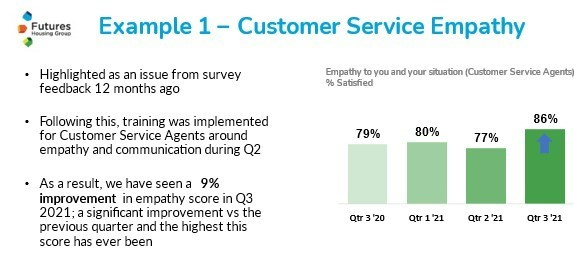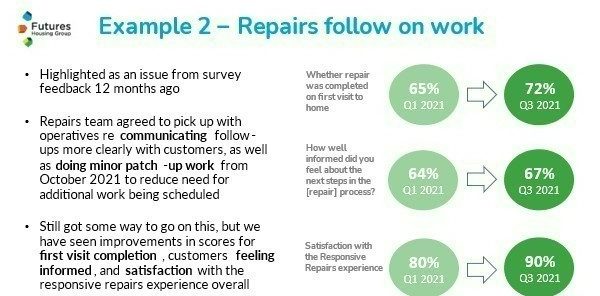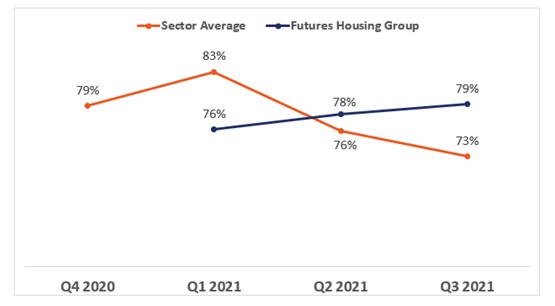
Engaging your staff in customer feedback is pivotal to creating long lasting, effective change. Acutely aware of this, Futures Housing Group adapted their customer feedback in March 21 to engage staff without creating a ‘preaching’ or condescending tone to the delivery of information; while also creating a more holistic picture of customer satisfaction.
Earlier this week we shared key takeaways from our recent shared practice session addressing trends in data, looking at how external factors can influence customer satisfaction. In the second part of this series, we describe the learning Melanie Hughes, Research and Intelligence Manager at Futures Housing Group shared, of how the combination of operational and customer insight helped Futures explain surprising trends in their data over the last 12 months, which might have otherwise led to make the wrong assumptions or wrong actions.
Understanding surprising results
Futures Housing Group are a G1/V1 rated social housing provider based in the East Midlands with over 10,000 homes. In March 2021, Futures commissioned IFF Research as their research partner, incorporating online and telephone resident perception and transactional satisfaction surveys.
Keen to share satisfaction results internally on a quarterly basis, Futures and IFF worked together to create and deliver a report which brought together their customer satisfaction research and business intelligence, to give a fuller picture of what was impacting on customer satisfaction.
The benefit of this approach became evident in autumn 2021 when Futures’ contact centre unexpectedly went down due to a change in systems. They expected that customer satisfaction would drop because of this – as the main route for customers to raise repairs and other issues. However, they were surprised to see that customer satisfaction in fact remained steady during this time.
Melanie’s team carried out some investigation to understand why. What they discovered was that the number of repairs being reported hadn’t dropped. But, rather, customers had shifted from reporting repairs via the telephone to reporting repairs online. Their customers were able to self-serve and book their own repairs with ease, keeping satisfaction high.
By combining their knowledge of operational issues alongside their customer satisfaction data they were able to evidence that their online platform is an effective tool for customers. Without this approach, they may have missed how successful this repairs reporting method had become.
Engaging staff in service improvement
To engage staff in service improvement using customer feedback, following each quarterly presentation of results Futures and IFF run an action planning session, covering key areas for improvement, using small group workshops to discuss ways they could improve their services. To allow fresh ideas from across the business, the groups are not exclusive to a particular department. Each agreed action is given a timeframe, with someone taking ownership for seeing it through. Then, the following quarter, the improvements are evaluated against changes in satisfaction, to evidence whether it has been a successful improvement or not. Or, in some cases, if more time is needed.
This method of giving their team the opportunity to own the solutions and see the impact received really positive feedback from staff, and the levels of engagement have remained high since its launch.
But the proof is in the pudding as they say. Here’s how Futures evidenced the impact this approach has had:
In Q2 of 21/22 satisfaction with empathy shown by customer service staff dropped from 80% to 77%. One of the actions that came out of the following action planning session was to implement empathy training for staff. The following quarter this same measure hit an all-time high at 86% satisfaction.

The repairs service saw similar effects. In Q1 of 21/22 satisfaction with a repair being completed right first time was at 65%, customers feeling informed about next steps was at 64% and satisfactions with the overall repairs experience was at 80%. The repairs team discussed ways to improve these scores, and some of the team highlighted that there were opportunities to do minor patch work when attending customers’ homes, that weren’t specifically related to the job they were attending for. All repairs staff were also advised about the process of informing customers of next steps when they leave a property. By Q3, satisfaction with repair being resolved right first time had increased by 7% to 72%, customers feeling informed of next steps was up by 3% to 67% and satisfaction with the overall repairs experience was up from 80% to 90%.
And it’s not just on individual areas that Futures have seen improvements. Whilst the housing sector in general has seen a downward trend in customer satisfaction, Futures have seen the opposite.
Sharing their learning
Speaking of their successful service improvement, Melanie shared some learning with delegates…
The value of systems thinking

It is important to measure the right things. Customer satisfaction surveys should go beyond just asking 4 or 5 questions that don’t get to the heart of the issues. One system affects another. So, you need to take a step back and think about the individual questions and how they reflect the customer experience. Be aware of operational and environmental aspects that impact on satisfaction, and consider the full customer journey when evaluating their experience. Whilst internally you likely consider the contact centre and the repairs service to be two separate departments; to customers – their journey is singular and covers both of these areas. Make sure your surveys and the way you evaluate performance takes account of this.
Create the right environment

Position yourself to your stakeholders as a critical friend. Whilst you should be objective when critiquing what you observe, you also need to be supportive in how challenges can be overcome. This is where working with an independent agency can hold real value, as they can feed in context of what is going on, both in terms of your organisation’s performance, but also in the wider environment. They can also give advice on best practice – things that have worked elsewhere.
Share the presentation of results between you and your agency as this generates buy-in with your stakeholders and mitigates any defensiveness (“what do they know” etc). Collaborate on action planning. Don’t give recommendations about actions yourself, let stakeholders tell you what needs to be done. Get senior level support at the start, and identify the agents of change in your organisation.
Timing is everything
Play the long game. You’re not going to fix everything in one go but measuring at key intervals over time allows operational stakeholders to see where their actions are starting to have a solid and quantifiable impact. This gives them job satisfaction, gives them something to report on as part of their appraisals / strategy reviews and keeps them hungry for more ideas.
Need more guidance?
If you’d like help effectively engaging staff in service improvements, or you’re looking to better understand surprising results in your customer satisfaction data, we’re here to help. Contact our housing research specialists today to discover how we can help you get more from your data and boost customer satisfaction.